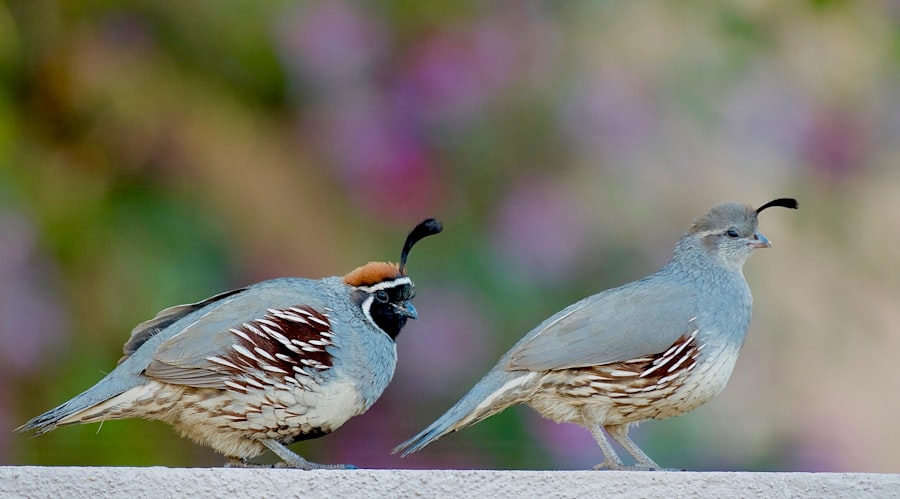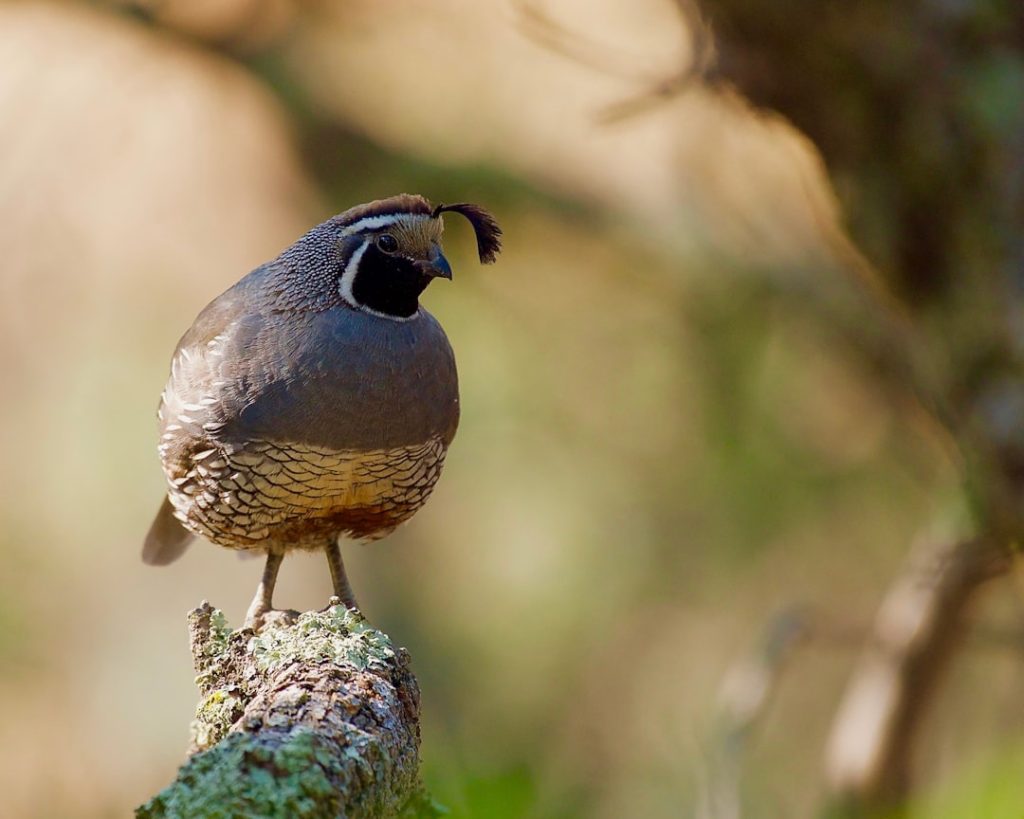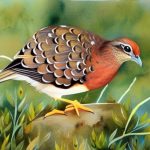Button quail, also known as Chinese painted quail, are small, ground-dwelling birds that belong to the family Odontophoridae. They are native to Southeast Asia and are popular among aviculturists for their small size, colorful plumage, and interesting behaviors. Button quail are often kept as pets or for breeding purposes due to their low maintenance requirements and relatively quiet nature.
These tiny birds are known for their distinctive button-like appearance, which is where they get their name. They come in a variety of colors, including silver, cinnamon, and pearl, making them a visually appealing addition to any aviary or household. Button quail are also known for their active and social nature, often seen foraging and interacting with each other in small groups. They are ground-dwelling birds and prefer to spend most of their time on the floor of their enclosure, making them well-suited for aviaries with ample floor space.
Button quail are relatively easy to care for and can be a great option for bird enthusiasts looking for a unique and low-maintenance pet. With the right care and housing, these birds can thrive and provide endless entertainment with their quirky behaviors and colorful plumage.
Table of Contents
Key Takeaways
- Button quail are small, ground-dwelling birds that are popular as pets due to their small size and low maintenance requirements.
- Care and housing for button quail involves providing a suitable enclosure with proper substrate, temperature, and diet to ensure their well-being.
- Breeding and reproduction of button quail can be successful with the right conditions, including a proper ratio of males to females and a suitable nesting area.
- The genetics of button quail play a role in determining their physical characteristics and color variations, making them an interesting subject for genetic studies.
- Common health issues for button quail include respiratory infections and egg binding, and proper care involves regular monitoring and providing a balanced diet.
When it comes to caring for button quail, providing the right housing and environment is crucial for their health and well-being. These birds require a spacious enclosure with plenty of floor space for foraging and socializing. A minimum enclosure size for a pair of button quail is around 2 square feet, but larger is always better to allow for more natural behaviors and exercise.
The flooring of the enclosure should be covered with a substrate that mimics their natural habitat, such as sand or fine gravel. This will allow the quail to engage in natural behaviors like dust bathing and foraging for food. Additionally, providing hiding spots and low perches will give the quail a sense of security and enrichment.
Button quail are social birds and should be kept in pairs or small groups to prevent loneliness and stress. However, it’s important to monitor their behavior to ensure that there is no aggression or bullying within the group. A balanced diet consisting of commercial game bird feed, fresh greens, and the occasional treat like mealworms or small insects will help keep button quail healthy and happy.
In terms of temperature and lighting, button quail thrive in moderate temperatures ranging from 60-75°F (15-24°C). They also require a consistent day-night cycle with access to natural or artificial light to maintain their circadian rhythms. Overall, providing a spacious and enriching environment with proper diet and social interaction is key to ensuring the well-being of button quail in captivity.
Breeding button quail can be a rewarding experience for aviculturists looking to expand their flock or produce offspring for sale. These birds reach sexual maturity at around 6-8 weeks of age, making them relatively easy to breed compared to other avian species. When it comes to breeding button quail, it’s important to provide a suitable nesting area within the enclosure to encourage natural mating behaviors.
A shallow dish filled with fine substrate like sand or peat moss can serve as a suitable nesting site for button quail. The female will lay a clutch of eggs over several days, usually laying one egg per day until the clutch is complete. It’s important to monitor the nesting area closely to ensure that the eggs are being properly incubated and that the parents are displaying good nesting behaviors.
Once the eggs are laid, they can be left in the care of the parents for incubation, or they can be removed and placed in an artificial incubator for more controlled conditions. The eggs typically hatch after 16-18 days of incubation, and the chicks are precocial, meaning they are born with their eyes open and are able to feed themselves shortly after hatching.
Providing a well-balanced diet and a stress-free environment is crucial for the successful breeding and rearing of button quail chicks. With proper care and attention to nesting behaviors, button quail can be prolific breeders, producing multiple clutches of eggs throughout the breeding season.
The genetics of button quail play a significant role in determining the color variations and patterns seen in these birds. Button quail come in a variety of colors, including silver, cinnamon, pearl, and more, with each color variation being controlled by specific genetic factors. Understanding the genetics behind these color variations is important for breeders looking to produce specific color morphs or improve the overall genetic diversity of their flock.
Button quail genetics follow a pattern of inheritance similar to other avian species, with traits being passed down from parent birds to their offspring through dominant, recessive, or sex-linked genes. For example, the silver color variation in button quail is controlled by a dominant gene, meaning that only one parent needs to carry the silver gene in order for offspring to display the silver coloration.
Breeders can use selective breeding techniques to produce specific color variations or patterns by pairing birds with desired traits and monitoring the offspring for the expression of those traits. Additionally, maintaining genetic diversity within a breeding population is crucial for preventing inbreeding depression and preserving the overall health and vitality of the flock.
By understanding the genetics behind color variations and patterns in button quail, breeders can make informed decisions when selecting breeding pairs and work towards producing healthy offspring with desirable traits.
Like all avian species, button quail are susceptible to a variety of health issues that can impact their well-being if not properly addressed. It’s important for bird enthusiasts and breeders to be aware of common health issues in button quail and take proactive measures to prevent illness and promote overall health.
One common health issue in button quail is respiratory infections, which can be caused by poor air quality, exposure to drafts, or bacterial or viral pathogens. Providing a clean and well-ventilated environment is crucial for preventing respiratory issues in button quail. Additionally, regular monitoring of the birds’ behavior and appearance can help identify early signs of illness so that appropriate veterinary care can be sought.
Another health concern for button quail is egg binding in females, which occurs when an egg becomes stuck in the reproductive tract and cannot be laid. This condition can be life-threatening if not promptly addressed, so it’s important to provide a well-balanced diet with adequate calcium levels to support egg production and prevent complications.
In addition to these specific health issues, maintaining good hygiene practices, providing a balanced diet, and monitoring the overall well-being of button quail are essential for preventing illness and promoting longevity. Regular veterinary check-ups can also help ensure that any potential health issues are identified early and addressed effectively.

Selective breeding plays a crucial role in the genetic improvement of button quail populations by allowing breeders to produce offspring with desirable traits such as specific color variations, patterns, or behavioral characteristics. By carefully selecting breeding pairs based on their genetic makeup and physical traits, breeders can work towards improving the overall quality and diversity of button quail populations.
One aspect of selective breeding involves identifying birds with desirable traits such as vibrant plumage colors or unique patterns and pairing them with compatible mates to produce offspring with similar traits. This process requires careful observation of individual birds and an understanding of their genetic makeup in order to make informed breeding decisions.
In addition to physical traits, behavioral characteristics such as docility, sociability, or reproductive success can also be targeted through selective breeding. By focusing on these traits, breeders can work towards producing button quail that are not only visually appealing but also well-suited for life in captivity as pets or breeding stock.
Maintaining genetic diversity within breeding populations is also crucial for preventing inbreeding depression and preserving the overall health and vitality of button quail populations. By carefully managing breeding pairs and avoiding close relatives in mating combinations, breeders can help ensure that offspring are healthy and genetically diverse.
Overall, selective breeding offers a powerful tool for genetic improvement in button quail populations by allowing breeders to produce offspring with specific traits that meet the needs of aviculturists and enthusiasts alike.
In conclusion, button quail are fascinating birds that offer unique opportunities for aviculturists and bird enthusiasts alike. With proper care and housing, these small ground-dwelling birds can thrive in captivity and provide endless entertainment with their colorful plumage and quirky behaviors. Breeding button quail can also be a rewarding experience for those looking to expand their flock or produce offspring with desirable traits.
Looking ahead, future directions for button quail care and breeding may involve further research into their genetics and color variations to better understand how specific traits are inherited and expressed. Additionally, efforts to promote conservation and genetic diversity within captive populations will be crucial for ensuring the long-term health and vitality of button quail.
By continuing to prioritize proper care, housing, selective breeding, and genetic improvement, aviculturists can work towards preserving the unique qualities of button quail while also promoting their well-being in captivity. With ongoing dedication to responsible care and breeding practices, button quail will continue to captivate bird enthusiasts around the world for years to come.
If you’re interested in learning more about the care, breeding, and genetics of button quails, you may also want to check out an article on PoultryWizard.com that provides valuable insights into creating the perfect chicken coop and run. This article offers practical tips and plans for building a functional and comfortable coop for your poultry. You can find it here.
FAQs
The button quail, also known as the Chinese painted quail, is a small ground-dwelling bird native to Southeast Asia and parts of Africa. They are popular as pets and are also bred for their eggs and meat.
Button quail require a suitable enclosure with plenty of space to move around, as well as a balanced diet of seeds, insects, and greens. They also need access to clean water and a warm, dry environment.
Breeding button quail requires a suitable nesting area, proper diet, and a stress-free environment. It is important to provide the right conditions for egg laying and incubation, as well as proper care for the chicks once they hatch.
When breeding button quail, it is important to consider genetic diversity and avoid inbreeding. Understanding the genetics of button quail can help breeders produce healthy and robust offspring.
Common health issues for button quail include respiratory infections, parasites, and injuries from rough handling or inadequate housing. It is important to monitor the health of button quail and seek veterinary care when necessary.
Meet Walter, the feathered-friend fanatic of Florida! Nestled in the sunshine state, Walter struts through life with his feathered companions, clucking his way to happiness. With a coop that’s fancier than a five-star hotel, he’s the Don Juan of the chicken world. When he’s not teaching his hens to do the cha-cha, you’ll find him in a heated debate with his prized rooster, Sir Clucks-a-Lot. Walter’s poultry passion is no yolk; he’s the sunny-side-up guy you never knew you needed in your flock of friends!







